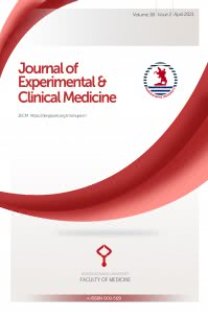İzofluran ve halotan anestezisi altında fruktoz ve glukoz solüsyonlarının akut metabolik etkilerinin karşılaştırmalı olarak incelenmesi
Asidoz, laktik, Anestezi, genel, Fruktoz, Glukoz, Halotan, İzofluran, Metabolizma
The comparison of the acute metabolic effects of fructose and glucose solutions under isofluorane or halothane anaesthesia
Acidosis, Lactic, Anesthesia, General, Fructose, Glucose, Halothane, Isoflurane, Metabolism,
___
1. Kayhan (Esener) Zeynep. Klinik Anestezi. 2. Baskı, İstanbul. Logos Yayıncılık. 1997; 354-375.2. Murroy RK, Granner DK. Mayes PA et al. Harper'ın Biyokimyası. İstanbul. Barış Kitapevi. 1993; 237-248.
3. Bergström J. Lactic acid accumulation in connection with fructose infusion. Acta Med Scand 1968: 184: 358-364.
4. Clarke RSJ. Anaesthesia and carbohydrale metabolism. Br J Anaesth 1973: 45; 237-243.
5. Nimmo WS. Smith C. Anaesthesia. London. Blackwell Scientific. 1989; 396-406.
6. Clarke RSJ. The hyperglycemic response to different types of surgery and anaesthesia. Br J Anacslh 1970: 42: 45-51.
7. Malatinsky J, Vigas M, Jurcovica J et al. The patterns of endocrine response to surgical stress during different types of anaesthesia and surgery in man. Acta Anaesth Belg 1986: 37: 23.
8. Moss J. Donlon JV. Goldrick KE. Stress response to local anaesthesia for cataract surgery. Anesthesiology 1986: 67(3A): 67.
9. SLeward DJ. Hyperglycemia. something else to worry about! Editorial. Paediatr Anaesth 1992; 2:81.
10. Price HL, Skousted P, Pauce AL. Evidence for betareceptor activation produced by halothane in normal man. Anesthesiology 1970; 32: 389-395.
11. Lacoumento S. Paterson JL. Burrin J et al. Effects of two differing halothane concentrations on the metabolic: and endocrine responses to surgery. Br J Anaesth 1986; 58: 844.
12. Kofhe WA, Hawkins RA. Davis DW et al. Comparison of the effects of volatile anesthetics on brain glucose metabolism in rats. Anesthesiology 1987: 66: 810-813.
13. Stevens WC. Eger El, Joas TA et al. Cnmparative toxicily of isoflurane. halothane, fluroxene and diethyl ether in human volunteers. Can Anaesth Soc 1973: 20: 357-368.
14. Komi J, Konchigci HN, Eckenhoff JE et al A new aneslhetic agent -Forane- preliminary observations in man. Anesth Analg 1972:51:439-447.
15. Sahebjami H. Scalettar R. Effccts of fructose infusion on lactate and urîc acid melabolism. Lancef 1968; I: 366-369.
16. Luke RG, Dinwoodie AJ, Linton AL et al. fructose and glucose tolerance in uremia. J Lab Clin Meri 1964: 64: 73 i.
17. Stevens WC. Cromvell TH. Halsey MJ. The cardiovascular effects of a new inhalation anesthetic, Forane. in human volunteers al constant arterial carbon diaside tension. Anesthesiology 1971; 39: 8-16.
18. Bylcs PH. Dobkin AB, Ferguson JH. Crossover comparison with enflurane (Ethrane), halothane and methoxynurane in dogs. Can. Anaest Soc J 1971; 18: 376-386.
19. Mori K, Kahyama A. Effects of fructose on left ventricular function during hypoxia. Masui 1994: 43: 859-S66.
20. Perheentupa J, Raivio K. Fructose-induced hyperurlcaemia. Lancet 1967; 2: 528.
21. Adalph M. Eckart A, Eckarl. J. Fructose vs. glucose in total parenteral nutrition in critically ill patients. Anaesthetist 1995; 44: 770-781.
22. Kawachi S. Sumiyoshi N. Yamamori Y et al. Utilizalion of a glucose/fructose/xylitnl carbohydrate solution during surgery. J Invest Surg 1993; 6: 477-484.
- ISSN: 1300-2996
- Yayın Aralığı: Yılda 4 Sayı
- Başlangıç: 2018
Bakan Nurten AKPOLAT, Tülin GÜMÜŞ, Ülkü AYPAR, Elif BAŞGÜL, MERAL KANBAK, Kemal ERDEM
Multivaryatif oluşum içeren bir kafatası
Mehmet Ali ÇAN, AHMET KALAYCIOĞLU, ZELİHA KURTOĞLU OLGUNUS
Toksoplazma antikorlarının Samsun yöresinde seroprevalansının araştırılması
Murat HÖKELEK, Yavuz UYAR, Murat GÜNAYDIN, Meryem ÇETİN
Çalışanlarda yüzeyel mikoz prevalansı ve etken mantarların belirlenmesi
Ayhan PEKBAY, Ahmet SANIÇ, Ayla YENİGÜN, BORA EKİNCİ, Satı ATİLLA, Evren KOSİF, Figen ÖZCAN
Soliter pulmoner nodüllerin malign-benign ayrımında dinamik kontrastlı BT incelemesi
Murat DANACI, Hüseyin AKAN, Ümit BELET, Lütfi İNCESU, Murat BAŞTEMİR, Mustafa Bekir SELÇUK
Kallus distraksiyon yöntemi ile alt ekstremite uzatma sonuçları
YILMAZ TOMAK, Nevzat DABAK, T. Nedim KARAİSMAİLOĞLU, Mustafa KARA, Hakan ÖZCAN
Hodgkin dışı lenfomalı olgularda Ca-125 düzeyinin değerlendirilmesi
